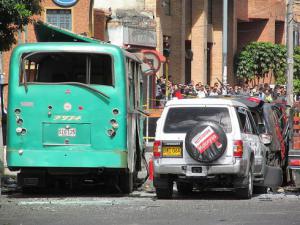ColombiaColombian government, FARC announce end to Latin America’s longest war
In a historic move, the Colombian government and Marxist FARC guerrilla movement have announced that they have reached a deal on a bilateral ceasefire — the last major step toward ending one of the world’s longest wars. The cease fire agreement will be signed on Thursday in Havana by President Juan Manuel Santos and FARC rebel leader Rodrigo Londono, better known by his nom de guerre Timochenko. The war between the Marxist FARC and successive Colombian governments began in 1964. It has claimed 220,000 lives and forced 6.6 million out of their homes. ”Un sueño que comienza a ser realidad,” tweeted Juan Manuel Santos, Colombia’s president.

FARC car bombing in Bogota Colombia targeting the former minister, Fernando Londono. // Source: commons.wikimedia.org
In a historic move, the Colombian government and Marxist FARC guerrilla movement have announced that they have reached a deal on a bilateral ceasefire — the last major step toward ending one of the world’s longest wars.
“We have arrived with success at an agreement on the bilateral and definitive ceasefire and end to hostilities,” the two sides said in a statement read to media in Havana. The two sides have been negotiating in Havana since 2012, under the auspices of the UN.
“Mañana será un gran día! Trabajamos por una Colombia en paz, un sueño que comienza a ser realidad. #SíALaPaz pic.twitter.com/yk7RI4yjrB
— Juan Manuel Santos (@JuanManSantos) 22 de junio de 2016
“A dream which is becoming a reality,” tweeted Colombian president Juan Manuel Santos.
FARC commander Carlos Lozada tweeted: “On Thursday, June 23, we will announce the last day of the war.”
The cease fire agreement will be signed on Thursday in Havana by President Juan Manuel Santos and FARC rebel leader Rodrigo Londono, better known by his nom de guerre Timochenko.
Al Jazeera reports that president Santos will be joined at the signing ceremony by the presidents of Cuba, Venezuela, and Chile, the three countries sponsoring the peace talks in Havana. The Obama administration’s special envoy, Bernard Aronson, and UN secretary general, Ban Ki-moon, will also attend the ceremony.
FARC (Fuerzas Armadas Revolucionarias de Colombia) was founded in 1964 with the help of the Castro government in Cuba. It was inspired by Che Guevara’s notion of a peasant revolution, and land reform has always been at the top of the group’s ideological agenda. It has waged a brutal war against successive Colombian governments, and in the 1980s and 1990s collaborated with the notorious Colombian drug cartels. In the mid-1990s, at the height of its power, FARC has controlled an area the size of Switzerland inside Colombia.
The 50-year war has killed more than 220,000 people and forced 6.6 million out of their homes (according to Amnesty International, Colombia has more internally displaced people than any other country in the world).
In the last fifteen years, a U.S.-backed military offensive has thinned the rebels’ ranks, while a generous U.S. economic aid program called Plan Colombia – launched by the Clinton administration in 1998 – persuaded many rural Colombians that there were better alternatives to joining the FARC.
The aging FARC leadership was weakening, and the successor generation of rebel leaders proved less loyal to Marxist dogma, and more willing to negotiate a deal with the government.
The ceasefire, which includes terms for the FARC’s demobilization and laying down of arms, will not begin until the final deal is signed.
Al Jazeeranotes that in addition to announcing a framework for the ceasefire, both sides said they agreed on how the FARC’s 8,000 fighters will demobilize and hand over their weapons, as well as the security guarantees the government will provide the rebels after the conflict ends.
UN observers will monitor the implementation of the various aspects of the agreement.
There are still some outstanding issues that must be dealt with. The major obstacle is to find a way to make sure that that the deal is not only ratified, but also given a legal force so it cannot be rescinded if a more conservative government is elected after Santos leaves office in 2018. A former conservative prime minister, Alvaro Uribe, now a leader of a small opposition party, has already announced his opposition to the agreement. He is supported by the families of the FARC’s many victims, who are upset with the amnesty the peace agreement offers rebel leaders.
The government insists that there is no blanket amnesty, and that rebels involved in the bloodiest atrocities will face justice.
Analysts say that the amnesty provisions, even if they allow for bringing a few FARC second-tier leaders to trial, are highly unpopular among Colombians who have lived in the shadow of FARC violence for two generations now, and it is thus not clear whether the agreement will be approved in a referendum that Santos has promised. It is also not clear whether a plebiscite will be held: the country’s constitutional judges must first approve the plebiscite law passed last year in Congress.
Colombians are also aware of the fact that a smaller insurgent group, the ELN (Ejército de Liberación Nacional), has announced that it was not part of the deal – but sources close to the Colombian government say that the two sides will soon begin negotiations.
The FARC announced a unilateral ceasefire last year, leading the government to halt airstrikes on rebel camps and limit ground operations.
Both the FARC and the ELN have been designated as terrorist organizations by the United States and the EU.
